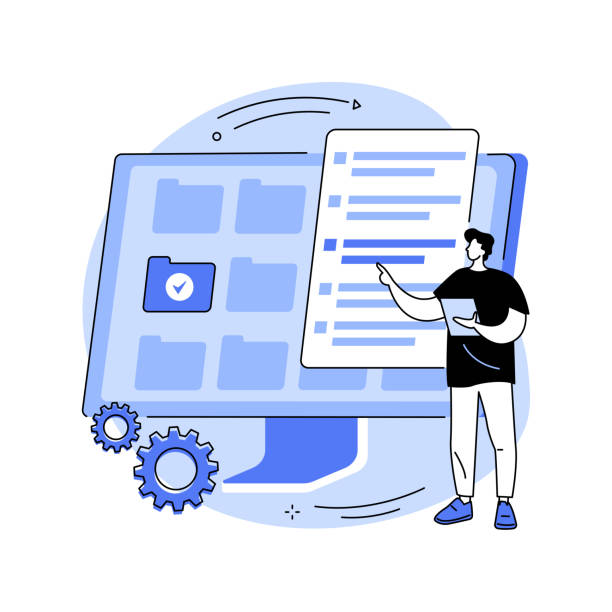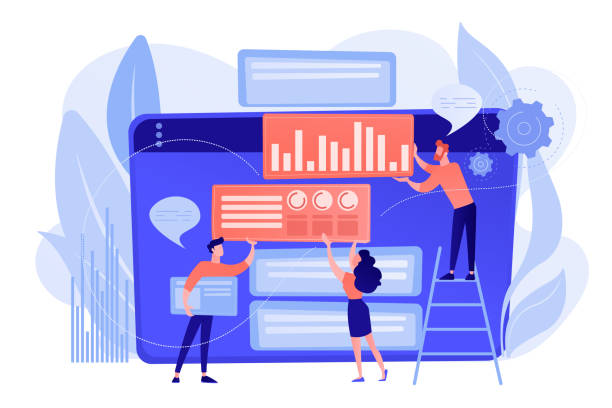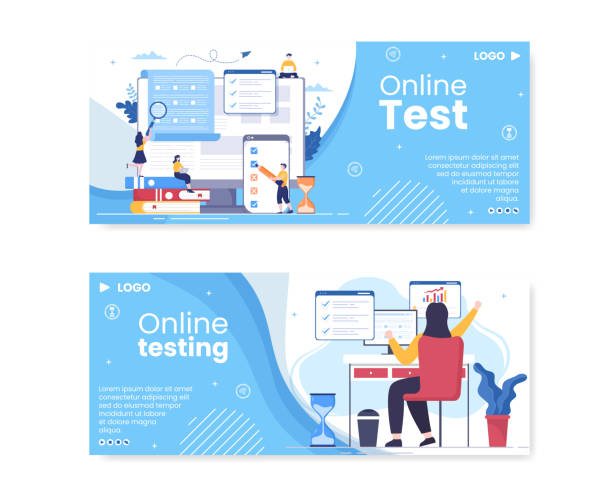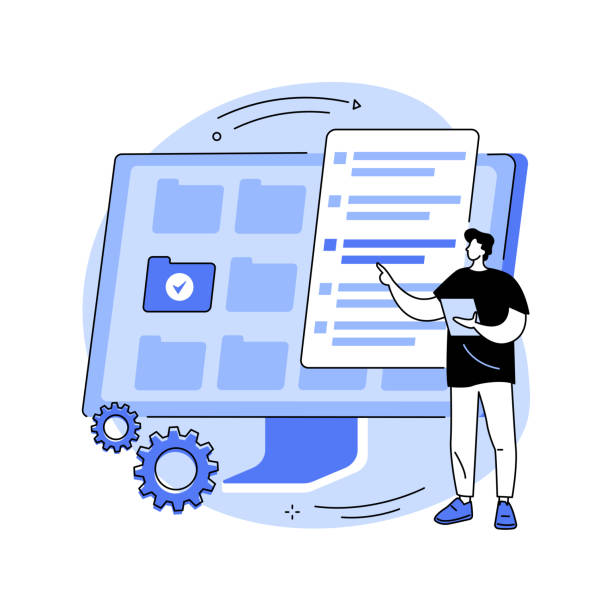Introduction and the Importance of Site Speed

In today’s digital world, website speed is not just a competitive advantage but a fundamental necessity.
When we talk about #Fast_Website_Design, we are not just referring to quick page loading, but rather the overall optimization of the digital platform to provide a smooth and uninterrupted user experience.
Research shows that even a one-second delay in page loading can lead to a significant decrease in user experience and conversion rates.
In an era where users expect to receive information in a fraction of a second, a slow site easily loses potential customers.
In addition to user experience, site speed is a vital factor in SEO (Search Engine Optimization).
Search engines like Google consider page loading speed as an important ranking signal.
In other words, a website with slower loading might rank lower than its competitors in search results, even if its content is of higher quality.
This is where the importance of Fast Website Design becomes even more apparent.
This article provides a comprehensive overview of factors effective in achieving a fast and optimized site, from choosing appropriate technologies to optimizing content and infrastructure.
Our goal is to provide practical guidance for anyone who wants to improve their online presence.
Are visitors leaving your e-commerce site before making a purchase? Don’t worry anymore! With Rasaweb’s professional e-commerce website design services, solve the problem of not converting visitors into customers forever!
✅ Significant increase in conversion rates and sales
✅ Unparalleled and engaging user experience
⚡ Contact us now for a free consultation!
Factors Affecting Site Speed

To achieve Fast Website Design, we must first understand the main factors that affect website loading speed.
These factors cover a wide range of technical issues, from the smallest coding details to larger infrastructures.
One of the most important factors is the size of the files on the page.
These files include images, videos, JavaScript scripts, and CSS files.
The larger the total size of these files, the more time it takes for the user’s browser to download them.
Therefore, compressing and optimizing these assets is of great importance.
Another factor is hosting quality.
A slow server or one with limited bandwidth can severely reduce your site’s speed, regardless of code optimizations.
Choosing a reliable hosting provider suitable for your site’s traffic needs is a fundamental step in ensuring speed.
Also, the number of HTTP requests that the browser sends to fully load the page is influential.
Each new request requires time for connection and data transfer.
Reducing the number of these requests, by combining files or using techniques like image sprites, can help speed up loading.
Furthermore, the structure and quality of website coding play a significant role.
Disorganized code, excessive use of plugins or heavy frameworks, and lack of database optimization can significantly slow down a site.
Fast Website Design requires a comprehensive approach where all these factors are carefully reviewed and optimized.
Understanding these factors helps developers and website owners implement effective strategies to improve their site’s performance.
Optimizing Images and Media

Images and media, while crucial for visual appeal and conveying meaning, often account for the largest share of a web page’s total size.
Proper optimization of images and other media assets is one of the most effective steps in achieving Fast Website Design.
The first step in this regard is compressing images without significant loss of quality.
Many tools are available for this purpose that can greatly reduce file size.
Using modern image formats like WebP can also help reduce file size while maintaining high quality.
In addition to compression, choosing the correct image dimensions is also crucial.
Loading an image with dimensions much larger than what is displayed on the screen only wastes bandwidth and loading time.
You should always upload images with dimensions proportionate to their display location on the website.
The “Lazy Loading” technique is also an excellent solution for Fast Website Design.
With this method, images and videos are loaded only when the user scrolls to the relevant section of the page, not immediately upon entering the page.
This has a significant impact on initial loading speed, especially for long pages with many images.
For videos, using external services like YouTube or Vimeo and embedding their codes, instead of directly hosting videos on your own server, can greatly reduce the load on your server.
Additionally, compressing videos into optimized formats and using lightweight players is also important.
Media optimization not not only increases site speed but also reduces user data consumption, which is very beneficial for users with limited internet connections.
These methods help you have a high-performance website without sacrificing visual quality.
| Image Optimization Technique | Description | Impact on Speed |
|---|---|---|
| Lossless Compression | Reduces image file size without affecting visual quality. | Reduces image download time |
| Use of WebP Format | Modern and more efficient format for smaller image files. | Significant improvement in loading speed |
| Resizing Images | Using images with precise dimensions required for display. | Prevents loading of extra data |
| Lazy Loading | Loads images only when the user needs them. | Increases initial page loading speed |
| CDN for Images | Distributes images across global servers for faster access. | Reduces latency in image loading |
Choosing the Right Host and CDN

The foundation of any fast and reliable website is choosing a strong hosting and utilizing a CDN (Content Delivery Network).
Even the best coding and content optimization cannot compensate for the performance of a weak server.
In Fast Website Design, your hosting type is extremely important.
Shared hosting plans are cheaper but share server resources with many other websites, which can severely impact your site’s speed, especially during peak traffic.
For websites with moderate to high traffic, Virtual Private Servers (VPS) or dedicated servers are better options as they offer guaranteed resources.
Also, Cloud Hosting, with its high flexibility and scalability, is a popular choice for achieving optimal performance.
Important factors in choosing a host include server location (proximity to target audience), bandwidth, storage type (SSD instead of HDD), and strong technical support.
A hosting provider with excellent support can minimize downtime during issues and help maintain your site’s speed.
A CDN is a network of servers distributed across various geographical locations worldwide that store your website’s static content (such as images, CSS, and JavaScript).
When a user visits your website, the CDN delivers the content from the server closest to them.
This significantly reduces latency and increases loading speed, especially for users located farther from your main server.
Using a CDN is one of the most effective ways to globally increase site loading speed and improve user experience, and it is an integral part of a comprehensive fast website design strategy.
Did you know that customers’ first impression of your company is your website? Multiply your business’s credibility with a powerful corporate website from Rasaweb!
✅ Custom and eye-catching design tailored to your brand
✅ Improved user experience and increased customer attraction
⚡ Get a free consultation now!
Optimized Coding and Project Structure

The beating heart of any website is its code.
Optimized coding and a proper project structure are fundamental pillars in Fast Website Design.
Clean, concise, and efficient code not only helps the website load faster but also makes its future maintenance and development easier.
The first step in this regard is reducing the size of CSS and JavaScript files.
This is done by removing unnecessary code, minification, and concatenation of files.
Many automated tools are available for this purpose that can perform this process quickly.
Next is optimizing how scripts and styles are loaded.
Placing CSS files in the page’s <head> section and JavaScript files at the end of the <body>, or using async and defer attributes for scripts, allows the main page content to load sooner, improving the user’s initial visual experience.
This approach enables the browser to render the page structure before executing complex scripts.
The use of JavaScript frameworks and libraries should also be done carefully.
While these tools can accelerate development, using heavy frameworks for small projects or loading entire libraries when only a small portion is needed can severely impact speed.
Choosing lighter components or using “tree shaking” to remove unused code are advanced techniques in code optimization.
Finally, efficient database design and the use of optimized queries also play a significant role in the speed of websites that heavily rely on data.
An optimized database significantly reduces server response time, thereby greatly contributing to fast website design.
The Role of Caching in Fast Website Design

One of the most powerful tools for achieving Fast Website Design is the use of Caching.
Caching means temporarily storing data and versions of website content so that in subsequent visits, this content is available faster, reducing the need for re-loading from the main server.
This significantly reduces the number of requests to the server as well as server processing time, which results in faster page loading for users.
- Browser Caching: This type of cache instructs the user’s browser to store static files such as images, CSS, and JavaScript in its local memory for a specified period.
Therefore, on subsequent visits to the same site, these files are loaded directly from the browser’s cache instead of being re-downloaded from the server.
This provides an excellent user experience, especially for frequent visitors to your site. - Server Caching: In this method, the website server stores page responses or database data.
When a request for cached content is received, the server can immediately provide the response without needing to fully process the request or interact with the database.
This type of caching is particularly effective for dynamic sites whose content rarely changes. - CDN Caching: As mentioned earlier, Content Delivery Networks (CDNs) also use caching to store and deliver static content from servers closest to the user.
Intelligent use of caching is a vital element in the Fast Website Design strategy.
By correctly configuring cache headers and choosing appropriate caching solutions for each content type, you can significantly reduce your site’s loading time and optimize server bandwidth.
This is an investment that directly positively impacts performance and user experience.
Site Speed Measurement Tools

After applying various optimizations, how can we ensure the success of our actions? Accurate site speed measurement and identifying potential bottlenecks are the crucial next steps in the Fast Website Design process.
Fortunately, powerful and free tools are available to help you evaluate your website’s performance and receive suggestions for improvement.
Regular use of these tools allows you to track the impact of implemented changes and continuously monitor your site’s speed.
- Google PageSpeed Insights: This Google tool evaluates both desktop and mobile loading speeds and gives your site a score from 0 to 100.
It also provides a list of opportunities for improvement and diagnostics for troubleshooting.
This tool uses both real user data (Field Data) and laboratory data (Lab Data) for analysis. - GTmetrix: GTmetrix is a comprehensive tool that analyzes your site’s performance using Google Lighthouse and YSlow.
This tool not only provides performance scores but also displays a detailed Waterfall chart of page requests, helping you see the loading order of each component and the time spent on it. - Pingdom Tools: Similar to GTmetrix, Pingdom Tools also provides an overview of your site’s performance, including Waterfall analysis, page size, and the number of requests.
This tool allows you to choose the test location, which is useful for evaluating performance for different geographical audiences. - WebPageTest: This tool is very powerful and flexible, allowing you to perform more complex tests with advanced settings such as connection speed, browser, and geographical location.
WebPageTest provides precise results including First Byte Time, Start Render, and Speed Index.
With these tools, you can analytically identify your site’s speed issues and implement appropriate solutions to improve overall website performance in line with Fast Website Design.
This continuous monitoring and optimization process helps maintain and enhance your site’s position in search engines and user satisfaction.
| Tool Name | Key Features | Main Use |
|---|---|---|
| Google PageSpeed Insights | Scoring 0-100, improvement suggestions (desktop/mobile), field and lab data | Overall performance evaluation and Google’s recommendations |
| GTmetrix | Lighthouse and YSlow analysis, Waterfall chart, comprehensive performance report | Deep performance and resource analysis |
| Pingdom Tools | Performance report, Waterfall chart, tests from different locations | End-user speed monitoring |
| WebPageTest | Advanced settings (connection type, browser, location), detailed loading of each element | Highly precise and customized analysis |
Security and Speed: Is There a Conflict?

Sometimes the question arises whether implementing strong security measures can negatively impact website speed? This is a controversial topic with a complex but important answer.
At first glance, it might seem that data encryption (such as using SSL/TLS), firewalls, and intrusion detection systems can impose more processing on the server and slow down speed.
However, in reality, with the right approach, security not only doesn’t conflict with Fast Website Design but can also help it.
For example, using an SSL/TLS certificate (which enables HTTPS) is essential for encrypting communication between the user’s browser and the server.
In the past, this process might have introduced a slight delay.
However, with technological advancements, especially with newer protocols like HTTP/2 which are enabled via HTTPS, SSL overhead has been minimized and can even help improve performance.
HTTP/2 offers features like multiplexing and header compression, which lead to faster page loading.
On the other hand, an insecure site can become a victim of DDoS attacks, which directly lead to site slowdown or unavailability.
In this scenario, speed is zero.
Therefore, security measures such as using Web Application Firewalls (WAF), Intrusion Detection/Prevention Systems (IDS/IPS), and regularly updating systems and plugins not only protect your site but also ensure its stability and availability.
In fact, stable security means stable speed.
A Fast and Secure Website Design attracts user trust and improves SEO rankings.
Therefore, instead of viewing security as an obstacle to speed, it should be considered a key factor in the long-term stability and performance of a website.
Are you bothered by losing customers due to your e-commerce site’s outdated appearance or slow speed? Rasaweb’s expert team solves these problems with professional e-commerce website design!
✅ Increase customer trust and your brand’s credibility
✅ Stunning speed and excellent user experience
Get a free consultation with Rasaweb right now ⚡
The Future of Fast Website Design and New Trends

The world of the web is constantly evolving, and with the emergence of new technologies, the concept of Fast Website Design also undergoes changes.
Future trends are based on providing an even faster, smoother, and richer user experience.
One of the most important emerging trends is the increasing use of Progressive Web Apps (PWAs).
PWAs are websites that bring mobile app capabilities (such as offline work, push notifications, and device feature access) to the browser and are naturally very fast and responsive.
Another rapidly growing technology is WebAssembly (Wasm).
Wasm allows developers to bring high-performance code from languages like C++, Rust, and Go to the web.
This can lead to much faster execution of computationally intensive tasks in the browser, providing unprecedented speed for complex applications and web-based games.
Furthermore, continued optimization of network protocols like HTTP/3, built on QUIC, promises further latency reduction and improved performance on unstable networks.
This protocol, due to its features such as zero round-trip loss for connection initiation and improved packet loss management, can significantly contribute to site speed.
Additionally, Artificial Intelligence (AI) and Machine Learning (ML) can also play a role in future automated website optimization.
For instance, AI-powered tools can automatically compress images, remove unnecessary code, or suggest the best caching strategy based on user traffic patterns.
These developments indicate that Fast Website Design is not a static concept but a dynamic field that pushes the boundaries of web performance with every new innovation, elevating user experiences to new levels.
Challenges of Maintaining Speed Over Time

Achieving Fast Website Design is only half the battle; maintaining this speed over time presents its own challenges.
Websites are living entities that are constantly growing and changing.
Adding new content, installing more plugins, software updates, and increased user traffic can all gradually negatively impact site speed.
Therefore, a continuous maintenance and monitoring strategy is essential to preserve optimal performance.
One of the biggest challenges is content management.
New images and videos must always be optimized before uploading.
Also, old content that is no longer used or is high in volume should be identified and optimized or removed.
Many websites experience slowdowns due to the accumulation of unoptimized media files.
Another challenge is managing plugins and themes.
Every new plugin or theme installed adds more code and HTTP requests to the site.
Using too many plugins or low-quality plugins can seriously affect site speed.
Regularly reviewing and removing unnecessary plugins or replacing them with lighter alternatives is an important action.
Also, software updates for the Content Management System (CMS), themes, and plugins should be performed regularly.
These updates are not only crucial for security but often include performance optimizations as well.
However, each update can introduce new challenges, so thorough testing after every update is essential.
Continuous monitoring with speed and performance tracking tools, such as those mentioned previously, helps you quickly identify any drop in speed and address it before it negatively impacts user experience.
Ultimately, maintaining Fast Website Design is an ongoing process that requires constant attention and commitment.
Frequently Asked Questions
| No. | Question | Answer |
|---|---|---|
| 1 | What is “Fast Website Design”? | Designing a site that loads in the shortest possible time and provides a smooth user experience, with an emphasis on performance optimization. |
| 2 | Why is site loading speed important for users? | Today’s users have little patience; slow sites lead to early page abandonment, poor user experience, and loss of visitors. |
| 3 | What impact does fast website design have on SEO? | Search engines like Google consider site speed as one of the ranking factors. Faster sites achieve better rankings in search results. |
| 4 | What are the main factors affecting site speed? | Image optimization, caching, CSS and JS file compression, use of powerful hosting, reduction of HTTP requests, and optimized coding. |
| 5 | How can site loading speed be measured? | Using tools like Google PageSpeed Insights, GTmetrix, Lighthouse, and Pingdom Tools, which provide accurate reports on site performance. |
| 6 | What is the role of images in site speed and how should they be optimized? | High-volume images can severely reduce site speed. They should be compressed, modern formats (like WebP) should be used, and Lazy Load technique should be employed. |
| 7 | What is the importance of choosing suitable hosting in fast website design? | A powerful and high-speed hosting (preferably SSD) with optimized servers close to the target users is the foundation of a site’s speed. |
| 8 | How does Caching help increase site speed? | Caching allows the user’s browser to store versions of site files, so on subsequent visits, there’s no need to reload all content, and the site displays faster. |
| 9 | Is using a CDN (Content Delivery Network) recommended in fast website design? | Yes, CDN significantly increases loading speed by storing copies of site content on various geographical servers and delivering it from the closest server to the user. |
| 10 | What are the key tips for developers to design a high-speed website? | Writing clean and optimized code, minimal use of plugins, optimizing database queries, using lightweight frameworks, and implementing Lazy Load for content. |
And other services of Rasaweb Advertising Agency in the field of advertising
Smart Customer Journey Map: An innovative platform to improve customer behavior analysis with SEO-driven content strategy.
Smart Direct Marketing: A blend of creativity and technology to improve SEO rankings through key page optimization.
Smart PR (Advertorial) Management: A fast and efficient solution for campaign management focusing on custom programming.
Smart Direct Marketing: A dedicated service for growth in campaign management based on intelligent data analysis.
Smart Content Strategy: Professional optimization for increased sales using intelligent data analysis.
And over a hundred other services in the field of internet advertising, advertising consultation, and organizational solutions.
Internet Advertising | Advertising Strategy | Advertorials
📍 Tehran, Mirdamad Street, Next to Central Bank, Southern Kazeroun Alley, Ramin Alley, No. 6


